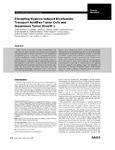Disrupting Hypoxia-Induced Bicarbonate Transport Acidifies Tumor Cells and Suppresses Tumor Growth
| dc.contributor.author | McIntyre, A | |
| dc.contributor.author | Hulikova, A | |
| dc.contributor.author | Ledaki, I | |
| dc.contributor.author | Snell, C | |
| dc.contributor.author | Singleton, D | |
| dc.contributor.author | Steers, G | |
| dc.contributor.author | Seden, P | |
| dc.contributor.author | Jones, D | |
| dc.contributor.author | Bridges, E | |
| dc.contributor.author | Wigfield, S | |
| dc.contributor.author | Li, J-L | |
| dc.contributor.author | Russell, A | |
| dc.contributor.author | Swietach, P | |
| dc.contributor.author | Harris, AL | |
| dc.date.accessioned | 2016-08-09T14:26:56Z | |
| dc.date.issued | 2016-07-01 | |
| dc.identifier.issn | 0008-5472 | |
| dc.identifier.issn | 1538-7445 | |
| dc.identifier.uri | http://hdl.handle.net/10026.1/5238 | |
| dc.description.abstract |
Tumor hypoxia is associated clinically with therapeutic resistance and poor patient outcomes. One feature of tumor hypoxia is activated expression of carbonic anhydrase IX (CA9), a regulator of pH and tumor growth. In this study, we investigated the hypothesis that impeding the reuptake of bicarbonate produced extracellularly by CA9 could exacerbate the intracellular acidity produced by hypoxic conditions, perhaps compromising cell growth and viability as a result. In 8 of 10 cancer cell lines, we found that hypoxia induced the expression of at least one bicarbonate transporter. The most robust and frequent inductions were of the sodium-driven bicarbonate transporters SLC4A4 and SLC4A9, which rely upon both HIF1α and HIF2α activity for their expression. In cancer cell spheroids, SLC4A4 or SLC4A9 disruption by either genetic or pharmaceutical approaches acidified intracellular pH and reduced cell growth. Furthermore, treatment of spheroids with S0859, a small-molecule inhibitor of sodium-driven bicarbonate transporters, increased apoptosis in the cell lines tested. Finally, RNAi-mediated attenuation of SLC4A9 increased apoptosis in MDA-MB-231 breast cancer spheroids and dramatically reduced growth of MDA-MB-231 breast tumors or U87 gliomas in murine xenografts. Our findings suggest that disrupting pH homeostasis by blocking bicarbonate import might broadly relieve the common resistance of hypoxic tumors to anticancer therapy. Cancer Res; 76(13); 3744–55. ©2016 AACR. | |
| dc.format.extent | 3744-3755 | |
| dc.format.medium | Print-Electronic | |
| dc.language | en | |
| dc.language.iso | en | |
| dc.publisher | American Association for Cancer Research (AACR) | |
| dc.subject | Animals | |
| dc.subject | Antigens, Neoplasm | |
| dc.subject | Apoptosis | |
| dc.subject | Bicarbonates | |
| dc.subject | Blotting, Western | |
| dc.subject | Carbonic Anhydrase IX | |
| dc.subject | Cell Proliferation | |
| dc.subject | Female | |
| dc.subject | Humans | |
| dc.subject | Hydrogen-Ion Concentration | |
| dc.subject | Hypoxia | |
| dc.subject | Hypoxia-Inducible Factor 1, alpha Subunit | |
| dc.subject | Mice | |
| dc.subject | Mice, Inbred BALB C | |
| dc.subject | Mice, SCID | |
| dc.subject | Neoplasms | |
| dc.subject | RNA, Messenger | |
| dc.subject | Real-Time Polymerase Chain Reaction | |
| dc.subject | Reverse Transcriptase Polymerase Chain Reaction | |
| dc.subject | Sodium-Bicarbonate Symporters | |
| dc.subject | Tumor Cells, Cultured | |
| dc.subject | Xenograft Model Antitumor Assays | |
| dc.title | Disrupting Hypoxia-Induced Bicarbonate Transport Acidifies Tumor Cells and Suppresses Tumor Growth | |
| dc.type | journal-article | |
| dc.type | Article | |
| plymouth.author-url | https://www.ncbi.nlm.nih.gov/pubmed/27197160 | |
| plymouth.issue | 13 | |
| plymouth.volume | 76 | |
| plymouth.publication-status | Published | |
| plymouth.journal | Cancer Research | |
| dc.identifier.doi | 10.1158/0008-5472.CAN-15-1862 | |
| plymouth.organisational-group | /Plymouth | |
| plymouth.organisational-group | /Plymouth/REF 2021 Researchers by UoA | |
| plymouth.organisational-group | /Plymouth/REF 2021 Researchers by UoA/UoA01 Clinical Medicine | |
| plymouth.organisational-group | /Plymouth/REF 2021 Researchers by UoA/UoA01 Clinical Medicine/UoA01 Clinical Medicine | |
| dc.publisher.place | United States | |
| dcterms.dateAccepted | 2016-04-25 | |
| dc.rights.embargodate | 2017-5-17 | |
| dc.identifier.eissn | 1538-7445 | |
| dc.rights.embargoperiod | Not known | |
| rioxxterms.versionofrecord | 10.1158/0008-5472.CAN-15-1862 | |
| rioxxterms.licenseref.uri | http://www.rioxx.net/licenses/all-rights-reserved | |
| rioxxterms.licenseref.startdate | 2016-07-01 | |
| rioxxterms.type | Journal Article/Review |


